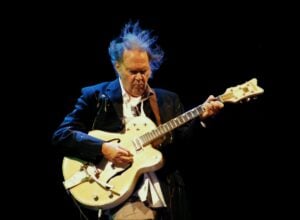12 Classic Rock Songs Inspired by the Movies We’ve All Loved for Decades

Photo by Eric Meola, Columbia Records, Public domain, via Wikimedia Commons
Here are some classic rock songs inspired by movies many of us grew up watching. Some influences are clear, others are hidden until you listen closely. These songs weren’t written for films. Instead, an artist saw a movie, felt something spark, and went home ready to create.
With that in mind, here’s a fresh look at 12 classic rock tracks shaped by the big screen.
Metallica — “One” (1988)
This Metallica classic was shaped by Dalton Trumbo’s Johnny Got His Gun, a bleak film about a wounded soldier trapped in his own mind. The band lifted scenes directly from the movie for the music video, which helped many fans discover the original story. The song mirrors the film’s mood, highlighting the inner world of a young man who can no longer communicate.
The lyrics leave nothing to guesswork:
“Darkness imprisoning me / All that I see / Absolute horror…” The song expands on the film’s themes of loss and isolation, echoing a story that remains one of the strongest anti-war messages ever captured on film and record.
Aerosmith — “Walk This Way” (1975)
Aerosmith found inspiration for this hit after watching Mel Brooks’ Young Frankenstein. The movie was still showing in theaters when the band saw it, and one of its most famous jokes became the song’s title. Guitarist Joe Perry shared this story years later, making it clear that the film’s humor directly influenced their writing.
Mel Brooks later said the joke came from early theater comedy and that he reused it many times. Aerosmith turned that small moment into a rock anthem, showing how even quick movie gags can spark ideas that end up shaping major songs.
Bruce Springsteen — “Nebraska” (1982)
Springsteen has openly said that Badlands shaped the entire tone of his Nebraska album. The film follows a teenage girl and her boyfriend on a violent spree, and the mood carries into the title track. Springsteen even mirrors the film’s opening imagery with lines like:
“I saw her standing on her front lawn just twirling her baton…”
Though Springsteen changes some details, the influence is clear. The song builds a quiet but unsettling sense of motion, reflecting the film’s portrayal of two young people drifting into danger while trying to outrun everything around them.
Bonnie Tyler — “Total Eclipse of the Heart” (1983)
Jim Steinman wrote this song while working on a musical version of Nosferatu, the silent German vampire film from 1922. He said, “Its original title was ‘Vampires in Love’… If anyone listens to the lyrics, they’re really like vampire lines.” The movie’s dark themes helped shape the emotional pull of the song.
The track later appeared in the Broadway musical Dance of the Vampires, itself inspired by Roman Polanski’s The Fearless Vampire Killers. The song’s dramatic energy fits the vampire world so well that it continued to find life in stage productions long after its release.
Roxy Music — “2HB” (1972)
Bryan Ferry wrote “2HB” with Casablanca in mind. The title references Humphrey Bogart, and the chorus includes the line “Here’s looking at you kid,” one of the most famous quotes from the film. It’s a subtle tribute, but the influence becomes clearer when you notice the tone and pacing of the song.
The lyrics even reveal the film’s ending:
“Ideal love flies away now… / You gave her away to the hero.”
Ferry’s approach shows how a movie can inspire a mood rather than a direct retelling, turning cinematic themes into a smooth, atmospheric track.
Bob Dylan — “Motorpsycho Nightmare” (1964)
Dylan blends references to La Dolce Vita with a stronger nod to Alfred Hitchcock’s Psycho. He even name-checks Anthony Perkins and reimagines the famous shower scene in a humorous way. The song turns suspense into satire while keeping the film’s edge in full view.
The clearest reference comes in the lyrics:
“There stood Rita, looking just like Tony Perkins / She said, ‘Would you like to take a shower?’…”
Dylan takes a moment of pure tension from the movie and reshapes it into a playful folk story.
Blue Öyster Cult — “Godzilla” (1977)
This song needs little explanation. Inspired by the iconic Japanese monster films, “Godzilla” retells the chaos and destruction that defined the character’s earliest movies. The band leans into the spectacle with lines that feel like a comic-book version of the film’s action.
The lyrics describe the towering creature moving through the city:
“He picks up a bus and he throws it back down…”
It’s a tribute that stays close to the screen while turning monster-movie imagery into a driving rock track.
Rush — “Cinderella Man” (1977)
Rush took inspiration from Mr. Deeds Goes to Town, the 1936 film starring Gary Cooper. The song reflects the good-hearted nature of Longfellow Deeds, a man who inherits a fortune and tries to use it to help others. The movie’s nickname for him, “the Cinderella Man,” becomes the heart of the song.
The lyrics follow the film’s themes:
“A modest man from Mandrake / Travelled rich to the city…”
Rush uses the story to explore ideas of kindness, morality, and how generosity can be misread in a cynical world.
David Bowie — “Space Oddity” (1969)
Bowie wrote “Space Oddity” after seeing 2001: A Space Odyssey while under the influence, later saying the film “really freaked me out.” The sense of isolation and wonder in the movie helped him create Major Tom, a fictional astronaut facing a tragic end.
The song was released just in time for the 1969 moon landing, and broadcasters even played it during coverage without realizing it described an astronaut stranded in space. Bowie captured the film’s eerie silence and turned it into one of his most enduring songs.
Bruce Springsteen — “Reason to Believe” (1982)
This track also draws from Badlands. The opening image, describing a man standing over a dead dog while poking it with a stick, mirrors early scenes from the film. Springsteen reshapes this image into a reflection on human behavior and how people search for hope in difficult moments.
Though the album’s first single once shared a title with A Fistful of Dollars, “Reason to Believe” stays rooted in quiet, grounded moments that echo the film’s tone rather than its storyline. The connection adds depth to a song built around small observations.
Deep Purple — “Why Didn’t Rosemary” (1969)
Deep Purple took inspiration from Rosemary’s Baby, Roman Polanski’s film about a young woman carrying the devil’s child. The band approached the story through direct references, blending rock elements with unsettling themes from the movie and the novel that inspired it.
The lyrics ask:
“Why didn’t Rosemary ever take the pill?…”
This simple question highlights the character’s sense of helplessness, turning the film’s psychological tension into a darker rock interpretation.
Guns N’ Roses — “Civil War” (1990)
This track opens with a line from Cool Hand Luke:
“What we’ve got here is… failure to communicate.”
Sampling that moment sets the tone for a song centered on conflict, inequality, and the cost of violence. The influence of movies on the band was something Slash often mentioned, noting how film shaped much of their creative thinking.
“Civil War” blends real-world issues with cinematic framing. By using a line many people recognize, Guns N’ Roses connects their message to a larger cultural memory shaped by decades of film history.
























